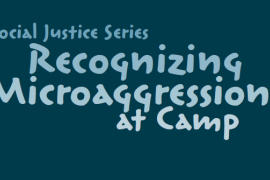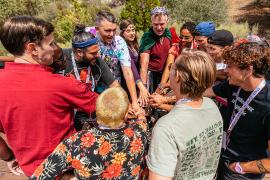Picky camp eaters — we all know them. In surveying the amount of leftovers on a given day and fielding phone calls from families and guardians about the food, this begs the question, “Why does camp food suck?”
The truth is it likely doesn’t. The more pointed question to ask is, “Do kids typically eat what we are serving?”
March is National Nutrition Month, which inspired us to broach the topic of food justice in this month’s issue of Camping Magazine. To establish a framework, food justice is one of the many prongs of social justice, the nuances of which we will explore further.
Talking about social justice in any iteration can be difficult — especially at camp. The difficulty stems from well-meaning camp professionals trying both to preserve the innocence of childhood and to avoid any potentially contentious topics that could present themselves in letters or calls home to families. Although many of us try our best to curate exclusively positive camp experiences by removing cell phone access or limiting daily news intake, camp only lasts a few months. Eventually, campers return to their communities and to contending with their everyday lives.
Merriam-Webster (2021) defines social justice as “a state or doctrine of egalitarianism.” Unpacking further, egalitarianism is defined by the same source “as a belief in human equality especially with respect to social, political, and economic affairs” (Merriam-Webster, 2021). Many of us have been conditioned to avoid topics of politics and economics — two of the pillars of social justice. No wonder it is so difficult to discuss at camp or elsewhere.
Breaking down social justice into palatable bites, food justice is a really great place to start. Food justice is the simple idea that all people should have access to healthy food. However, people of color are disproportionately impacted by hunger and diet-related illness as a result of both limited knowledge and access to quality food. This is especially true for food desert communities. For an area to be considered a food desert it must lack food availability and accessibility. Therefore, the residents are required to leave their immediate neighborhood to procure food products often as a result of municipal zoning laws and their low-economic status. The food justice movement seeks to increase access to healthier food by examining the root causes of these disparities: cracks in the political and economic systems and systemic racism. Together, these three roots work to oppress Black, Indigenous, People of Color (BIPOC) communities and continue the cycle of fast food, not fresh food.
Rethinking Food
Conversation and programming around food justice can be a powerful yet accessible way for you to join the social justice conversation at camp, where food is largely universal. Food is a necessity for all living things, so it is inherently unifying. Food is the offering that most cultures use to form community, provide comfort, and bring people together.
However, in addition to being used as a way to nurture lasting relationships, food has also been manipulated and used as a divisive and controlling force throughout history, both domestically and worldwide.
During ancient times, scorched-earth warfare was favored in Europe and the Middle East. This military tactic was very effective because, not only did it damage structural property, tools, and labor resources, it also destroyed land and food resources. This practice caused residual pain, famine, and starvation for the enemy and aided one in victory (Leebaw, 2014). Scorched-earth warfare continued to be used throughout history in notable wars, such as the American Civil War, WWI, and WWII.
During the 19th century, when manifest destiny guided white settlers west, they targeted bison populations as a way to remove Native Americans from their land. Following the long depression period, Colonel Dodge described the bisonless plains that once fed, clothed, and sheltered the Sioux, the Kiowa, and Comanche tribes as a graveyard where a myriad of carcass fouled the air with a “sickening stench, and the vast plain which only a short twelve months before teemed with animal life, was a dead, solitary desert” (Phippen, 2016). There’s that word again — desert — in reference to sustenance.
Looking to the antebellum American south, food given to slaves was used for practical purposes only and offered little variety. Slavery was driven and perpetuated by many motivations, one of which was economics. As such, the food served to slaves and their families was as inexpensive as possible to increase profit margins. In the Journal of Negro History, R.H. Taylor analyzed plantation records and food logs, uncovering the following:
“The cost of feeding exceeded perhaps any other single item of expense connected with the maintenance of slaves, and for that reason slave owners, as a rule, gave personal attention to the issuance of rations . . .The food therefore was, in the main, ample but coarse. Economy required that the slaves be given food produced in considerable quantities on the farms and plantations; consequently it was lacking somewhat in variety.”
Dietary patterns are based not only on access but also familiarity. As such, much of the way we eat is inherited, often collectively. If we want to understand how and what people eat, or conversely avoid, we need to be mindful of their food history.
While we are at camp, we largely eat the same things at the same time. We can use this commonality — and mindfulness about our individual relationships with food — as the perfect teaching tool for encouraging a healthy lifestyle among campers and improving their social-emotional intelligence.
Cultivating Nutritious Campers
Here’s what camps can do to make sure they are intentional and inclusive in their nutrition promotion:
- Start a community garden at camp. Community gardens foster responsibility, improved self-esteem among and aid in engagement and retention of children (Block et al., 2011). Gardening/urban farming is a life skill that bridges home and camp. This tangible skill not only enables children to grow food they know and will most likely eat at camp, but also equips them to return home and participate in their local community gardens. This civil participation and social awareness is an identified benefit of camp (American Camp Association, 2019).
- Don’t make assumptions about what kids eat. Instead, survey families by adding a question about typical eating habits to your camper enrollment form. Also offer campers detailed information about what’s on the menu for mealtime. Describe what it tastes like, what it does for the body, and who at camp enjoys that particular food. A photo of a balanced plate made from the day’s offerings as a model could also go a long way.
- Host make-a-meal events on Zoom with easily accessible, pantry staple ingredients. Try sending home the menu before camp starts and encouraging families to discuss and even prepare some of the dishes served at camp.
- Be intentional about nutrition at camp through your programming — what you’re serving and who is doing it. Offer cooking classes at camp using ingredients that are commonly found in all grocery store chains. Where possible, bake nutrition education and health into your physical activity blocks. Take a look at what’s on your menu and who is working in your kitchen. Representation matters there too.
Kindling Connections
This section of Trail Mixed was written by Morgan P. McGhee, MPH RD. McGhee’s earliest memories are in the outdoors camping with her family in the southeastern United States. While she has worked in schools for the majority of her career, she now works at FoodCorps, an AmeriCorps service program that connects kids to healthy food in schools. She writes:
Student: “Ew, I don’t want to eat that. It looks funny!”
Me: “Excuse me, let’s remember rule number 3 — ‘Please don’t yuck my yum!’”
This, like so many conversations with children about food, demonstrates a teachable moment. Researchers have long proven that some children must be exposed to foods up to 20 times before they’ll consume them (Loewen & Pliner, 1999). While we are being patient and teaching our young eaters that “healthy” is more about a feeling than a size or a look, we must also consider that by doing this we are empowering the next generation.
So what really is the harm in “yucking someone’s yum”? Well, when you disparage another person’s food choices it can create a sense of shame, and for children, it can impact what food choices they go on to make. As a young Black girl in the American South, I was told that the eating patterns of my culture were “bad,” which led to feelings of shame. My cultural identity and practices greatly impact how I interact with food and this socialization starts from a young age. Saying someone else’s food choices are not desirable because they are different is a personal bias. If this bias goes unchecked, it can do harm.
Communities of color are often the recipient of such biases, especially when they are left out of the conversation. We must educate ourselves to truly show up for children while engaging them in conversations about food.
Schools and camps can be a great location to further provide food education to children. This means exposing children through experiential learning opportunities beyond the classroom, such as garden education and cooking classes. We can also shift to a more just food system by empowering various populations. Whether it be your campers or students in schools, they can begin defining their own food practices (i.e., food sovereignty).
Children are incredibly smart and resilient. When we reimagine conversations around food practices and the impact these choices have on our lives, we can make progress in creating a more just and equitable food system.
We thank you, Morgan.
For More Information
Following are some additional resources for you to gain more knowledge about food justice and how it impacts communities of color:
- Talk to Morgan McGhee. She can be found tweeting at @speakingtheghee or on Instagram @moghee.
- Read Freedom Farmers: Agricultural Resistance and the Black Freedom Movement by Monica M. White, PhD.
- Watch the PBS documentary Food Forward: Food (Justice) For All, accessible online at pbs.org/video/food-forward-food-justice-all/.
- Listen to AnthroDish Podcast 84: "Anti-Racism in Dietetic Practice & Training with Gurneet Kaur Dhami," available on Spotify, Apple Podcast, and most podcast platforms.
Makela Elvy, M Ed, is an environmental educator and camp enthusiast. Along with Briana, she is also the co-founder of S'more Melanin — a platform dedicated to providing resources for BIPOC camp professionals. Over the course of her career, Makela has held camp positions ranging from head counselor to program manager. Her experience includes nature interpretation, curriculum development, and the creation of a 10-week venture program rooted in experiential learning.
Briana Mitchell has been a camp attendee since the age of six and a previous camp counselor and Teach for America Corps member. She is the director of AF Camp, a Change Summer camp, where she works to create high-quality summer opportunities for students that will increase their overall confidence, responsibility, curiosity, and independence. She is also the co-founder of S'more Melanin — a platform dedicated to providing resources for BIPOC camp professionals.
References
- American Camp Association (2019, April 04). Benefits of camp. Retrieved from ACAcamps.org/campers-families/because-camp/benefits-camp#:~:text=Camp%20provides%20children%20with%20a,%2Drespect%20%E2%80%94%20build%20personal%20competencies.
- Block, K., Gibbs, L., Staiger, P. K., Gold, L., Johnson, B., Macfarlane, S., . . . Townsend, M. (2011). Growing community. Health Education & Behavior, 39(4), 419-432.
- Phippen, J. (2016, May 13). Kill every buffalo you can! Every buffalo dead is an Indian gone. Retrieved from theatlantic.com/national/archive/2016/05/the-buffalo-killers/482349/
- Leebaw, B. (2014). Scorched earth: Environmental war crimes and international justice. Perspectives on Politics, 12(4), 770-788. Retrieved from jstor.org/stable/43280032
- Loewen, R. & Pliner, P. (1999) Effects of prior exposure to palatable and unpalatable novel foods on children’s willingness to taste other novel foods. Appetite, 32, 351– 366.
- Merriam-Webster. (2021). Egalitarianism. Retrieved from merriam-webster.com/dictionary/egalitarianism
- Merriam-Webster. (2021). Social justice. Retrieved from merriam-webster.com/dictionary/social%20justice
- Taylor, R. (1924). Feeding slaves. The Journal of Negro History, 9(2), 139-143.





